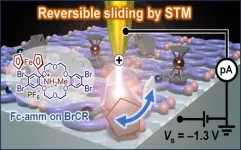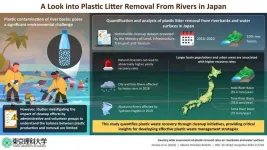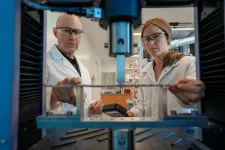(Press-News.org)
Artificial molecular machines, nanoscale machines consisting of a few molecules, offer the potential to transform fields involving catalysts, molecular electronics, medicines, and quantum materials. These machines operate by converting external stimuli, like electrical signals, into mechanical motion at the molecular level. Ferrocene, a special drum-shaped molecule composed of an iron (Fe) atom sandwiched between two five-membered carbon rings, is a promising foundational molecule for molecular machinery. Its discovery earned the Nobel Prize in Chemistry in 1973, and it has since become a cornerstone in the study of molecular machines.
What makes ferrocene so appealing is its unique property: A change in the electronic state of the Fe ion, from Fe+2 to Fe+3, causes its two carbon rings to rotate by about 36° around the central molecular axis. Controlling this electronic state by an external electrical signal could enable precisely controlled molecular rotation. However, a major hurdle in its practical application is that it readily decomposes when adsorbed onto the surface of substrates, especially flat noble metal substrates, near room temperature, even under ultra-high vacuum conditions. A definitive method for anchoring isolated ferrocene molecules on a surface without decomposition has not been found, until now.
In a groundbreaking study, a research team led by Associate Professor Toyo Kazu Yamada from the Graduate School of Engineering at Chiba University, Japan, including Professor Peter Krüger from the Faculty of Engineering at Chiba University, Professor Satoshi Kera of the Institute for Molecular Science, Japan, and Professor Masaki Horie of National Tsing Hua University, Taiwan, has finally overcome this challenge. They have successfully created the world’s smallest electrically controlled molecular machine. “In this study, we successfully stabilized and adsorbed ferrocene molecules onto a noble metal surface by pre-coating it with a two-dimensional crown ether molecular film. This is the first direct experimental evidence of ferrocene-based molecular motion at the atomic scale,” remarks Prof. Yamada. Their findings were published in the journal Small on November 30, 2024.
To stabilize the ferrocene molecules, the team first modified them by adding ammonium salts, forming ferrocene ammonium salts (Fc-amm). This improved durability and ensured that the molecules could be securely fixed to the surface of the substrate. These new molecules were then anchored onto a monolayer film made up of crown ether cyclic molecules, which were placed on a flat copper substrate. Crown ether cyclic molecules have a unique structure with a central ring that can hold a variety of atoms, molecules, and ions. Prof. Yamada explains, “Previously, we found that crown ether cyclic molecules can form a monolayer film on flat metal substrates. This monolayer trap the ammonium ions of Fc-amm molecules in the central ring of crown ether molecules, preventing the decomposition of ferrocene by acting as a shield against the metal substrate.”
Next, the team placed a scanning tunneling microscopy (STM) probe on top of the Fc-amm molecule and applied an electrical voltage, which caused a lateral sliding motion of the molecules. Specifically, on applying a voltage of −1.3 volts, a hole (vacant space left by an electron) enters the electronic structure of the Fe ion, switching it from Fe2+ to Fe3+ state. This triggered the rotation of the carbon rings accompanied by a lateral sliding motion of the molecule. Density functional theory calculations showed that this lateral sliding motion occurs due to the Coulomb repulsion between the positively charged Fc-amm ions. Importantly, on removing the voltage, the molecule returns to its original position, demonstrating that the motion is reversible and can be precisely controlled using electrical signals.
“This study opens exciting possibilities for ferrocene-based molecular machinery. Their ability to perform specialized tasks at the molecular level can lead to revolutionary innovations across many scientific and industrial fields, including precision medicine, smart materials, and advanced manufacturing,” says Prof. Yamada, highlighting the potential applications of their technology.
In summary, this study presents a crucial breakthrough in the design and control of molecular machines that can lead to significant advancements in numerous fields.
About Associate Professor Toyo Kazu Yamada
Dr. Toyo Kazu Yamada is currently an Associate Professor at the Graduate School of Engineering at Chiba University, Japan. He earned his Ph.D. (double degree) in 2004 from Radboud University Nijmegen, The Netherlands, and Gakushuin University, Japan. Additionally, he served as a Humboldt research fellow at the Karlsruhe Institute of Technology (KIT), Germany, from 2008 to 2010. His research primarily focuses on various aspects of materials science, encompassing single magnetic atoms and films, organic molecules, graphene nanoribbons, Fe/MgO interfaces, nanomagnets on an s-wave superconductor, and life molecules. His current research focuses on the functionality of a single magnetic atom or molecule on the surface of solid materials, such as magnetic substances and superconductors, as a quantum bit or quantum sensor for next-generation quantum computers.
END
Plastic pollution is an ever-growing problem in today’s world, as most societies have become overly dependent on plastics for packaging, medical supplies, and general goods. Plastic litter accumulation in the ocean, either through deliberate dumping or by being transported from a river, poses significant environmental challenges. Additionally, this plastic eventually degrades into small fragments called microplastics, which then impact diverse marine and land ecosystems by working their way up the food chain and into most living organisms. Though their negative effects on cell health are still under study, many nations have taken a cautionary stance, ...
EUGENE, Ore. — Dec. 12, 2024 — Tiny implantable sensors are helping University of Oregon researchers optimize the process of recovery from severe bone injuries.
Scientists at the UO’s Phil and Penny Knight Campus for Accelerating Scientific Impact have developed miniature implantable sensors that transmit real-time data about what’s happening at an injury site. In a new study, they use the technology to show that a resistance-training rehabilitation program can significantly improve femur injuries in rats ...
Fusion energy research is being pursued around the world as a means of solving energy problems. Magnetic confinement fusion reactors aim to extract fusion energy by confining extremely hot plasma in strong magnetic fields. Its development is a comprehensive engineering project involving many advanced technologies, such as superconducting magnets, reduced-activation materials, and beam and wave heating devices. In addition, predicting and controlling the confined plasma, in which numerous charged particles and electromagnetic fields interact in complex ...
A new study led by investigators from Mass General Brigham has identified a unique brain network that links varied patterns of brain atrophy, or shrinkage, associated with schizophrenia. By combining neuroimaging data from multiple studies involving more than 8,000 participants, the research team found a specific connectivity pattern of atrophy that was present across different stages and symptoms of schizophrenia — and distinct from brain networks associated with other psychiatric disorders. The findings will help to guide a clinical trial that will start recruiting patients soon and will ...
Research has long shown that humans are susceptible to “social identity bias”—favoring their group, whether that be a political party, a religion, or an ethnicity, and disparaging “outgroups.” A new study by a team of scientists finds that AI systems are also prone to the same type of biases, revealing fundamental group prejudices that reach beyond those tied to gender, race, or religion.
“Artificial Intelligence systems like ChatGPT can develop ‘us versus them’ biases similar to humans—showing favoritism toward their perceived ‘ingroup’ while expressing ...
It has been known for nearly 20 years that slow, synchronous electrical waves in the brain during deep sleep support the formation of memories. Why that is was previously unknown. Now, writing in the journal Nature Communications, a team of researchers from Charité – Universitätsmedizin Berlin posits an explanation. According to the study, the slow waves make the neocortex, the location of long-term memory, especially receptive to information. The findings could help to optimize the treatment approaches that are intended to support memory formation from outside.
How do permanent memories form? Experts believe that while we sleep, our brains replay the events of ...
Railways, the most climate-friendly mode of transport bar long-distance buses, are bound to play an important role in the fight for net zero. The total emissions of railway travel are currently 31 grams of CO2 equivalents (CO2e) per passenger kilometer, half the amount as for the most economical electrical vehicles.
But the carbon emissions of railway traffic can be further reduced, shows a new study in Frontiers in Sustainability by authors in Finland. This is because typical construction materials such as steel and concrete are energetically costly to produce, transport, handle, and maintain. Even on the ...
Food poisoning is a common, yet unpleasant, illness caused by eating contaminated items. It is sometimes caused by Clostridium perfringens, a pathogen widely found in soil and the intestinal tracts of animals.
The pathogen multiplies in environments with little oxygen, for example, curry stored in a pot. After ingestion of the pathogen, they form spores in the small intestinal tracts. The toxins produced during spore formation cause diarrhea and abdominal pain, but the underlying mechanism of spore formation has not been fully understood.
Associate Professor Mayo Yasugi’s team at Osaka Metropolitan University’s ...
A new study from Karolinska Institutet shows that long-term exposure to air pollution contributes to millions of deaths in India. The research, published in The Lancet Planetary Health, emphasises the need for stricter air quality regulations in the country.
Air pollution consisting of particles smaller than 2.5 micrometres in diameter, PM2.5, can enter the lungs and bloodstream and is a major health risk in India. Researchers have now examined the link between these particles and mortality over a ten-year ...
Inequalities in childhood vaccination are widening in England, with uptake rates of five key vaccines consistently lower in young children living in areas of higher deprivation from 2019 to 2023, finds a study published by The BMJ today.
The researchers say vaccine uptake was below the World Health Organization’s recommended 95% target for all vaccinations studied and call for urgent action to strengthen systems for childhood vaccination.
Protecting children from vaccine preventable diseases ...






